The latent transfer and storage of the confidential information on the Internet and cellular communication
(Rusian ver.)
 In many cases, alongside with enciphering of the confidential information, there is a need to make imperceptible the
fact of transfer or a data storage. The urgency of a problem directly is connected with growth of competitive struggle, the industrial espionage,
the increasing control of the state structures over an electronic communication facility, penetration of hackers into databases.
In many cases, alongside with enciphering of the confidential information, there is a need to make imperceptible the
fact of transfer or a data storage. The urgency of a problem directly is connected with growth of competitive struggle, the industrial espionage,
the increasing control of the state structures over an electronic communication facility, penetration of hackers into databases.
One of the most effective methods of counteraction to such intervention is concealment of data (Stenography) in a file of the digital image. The image will represent in this case the container (carrier) for transfer or storages of confidential data. Thus, access for viewing the image can be opened and to not cause suspicions. For a data storage, in this case, can be used not only the Data Center, but also usual HTTP servers. The transferred message preliminary is ciphered and will be transformed to binary sequence. At a following stage the binary sequence is embeded data file of the image. Dimension of data depends on a method of embedding, volume and brightness characteristics of the image-container.
Attempts of not authorized transformation of the image-container lead to loss of the latent data. Sharing of the Stenography approach and Cryptography provides practically insuperable barrier to breaking. Stability of the code breaking is defined exclusively by stability (length) of a confidential key.
Method of bit planes
The most known method is embedding of data in bit planes of the image. The algorithm of embedding is based on properties of visual perception, and is carried out so that introduced bats would remain imperceptible by visual consideration of the digital image. Usually, for performance of this condition, given are embeded in a bit plane with the least importance - 20 (LSB method). Volume Q of embeded data can be counted up under formula Q=P*W*H/B symbols, where P - number of the bit planes used for embedding, W and H - width and height of the image (pixels), accordingly, Â - number of bats on a symbol. The basic advantage of a method - simplicity of realization. The basic lack of this method is caused by the limited quantity of bit planes and as consequence, determinancy of embedding. It is possible to compensate last circumstance by hashing values of bit planes depending on values of brightness of the image-container, or depending on other criterion connected with properties of the image-container.
 |
 |
 |
| Fig. 1. | Fig. 2. | Fig. 3. |
Fig. 1 represents binary bidimentional sequence of data for concealment, and Fig. 2 and Fig. 3 show examples of embedding in bit planes.
In the first case, for embedding it is used three bit planes of the least zero bit 20,
and in the second - bit planes of four younger categories, for everyone color components (RGB), accordingly.
From comparison of images Fig. 2 and Fig. 3 it is visible, that the more bit planes embeded data, the above
smother a degree of distortions, visible to an eye. Application of textural images as containers, allows to
optimize a parity between quantity of data and quality of visual perception:
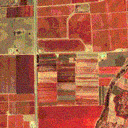
Fig. 4.
The data, in this image (Fig. 4.), borrow five bit planes, and make volume Q=30.7 Kb. The volume of the initial image-container is equal 49.2 Kb. The Operating ratio is equal 62 %. The significant volume of the container is connected with direct use BITMAP of formats of type BMP, TIFF, GIF, etc. If this factor will appear essential it is possible to take advantage of the structural method presented below.
Use of graphic files structure
The second method is based on the use of the internal structure of graphic formats. The structure of the graphic format is a kind of hierarchy functional and information segments (fields) of a digital image. Secret data is embedded in functional segments. The volume of embedded data is not related to the dimension of the container image. The main advantage of the method is that almost any structured data can be used as a container, including audio files (e.g. mp3), PDF format, ZIP, etc. An example of embedding a JPEG file in a comment field (label 0xFE) is illustrated by Figures fig. 5 and fig. 6.
 |
 |
| Fig. 5. | Fig. 6. |
Method of Holography
One more method is based on principles of digital holography. The hologram of confidential data is embededding in the image-container. This method creates conditional dependence between videodata of the container and built in confidential data and possesses the best security to breaking. Application of the holographic approach, allows to carry out embedding of the razed data in usual photos on a paper or plastic basis. For detection and restoration of confidential data the knowledge of parameters of creation of the hologram is required. The disadvantage of this method is due to the need to convert the hidden data into an image file format (BMP, JPEG, etc).
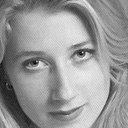 |
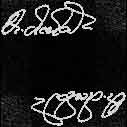 |
| Fig. 7. | Fig. 7a. |
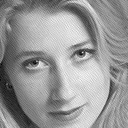 |
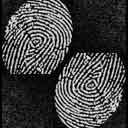 |
| Fig. 8. | Fig. 8a. |
It is the most expedient to apply the holographic approach to concealment images, which restoration supposes some loss (similarly to JPEG) qualities: samples of signatures, samples of prints of fingers, etc. Fig. 7 represents the container with embeded facsimile sample of the signature, and Fig. 7à shows result of restoration. The similar variant for concealment of a dactyloscopic print is illustrated Fig. 8 and Fig. 8a . The restored samples (Fig. 7a and Fig. 8a) have mirror display that is caused by occurrence of the real and imaginary image at restoration of the hologram. The option of transferring photos in the body of the container image is presented on the page: transfer photos of secret objects in a container image.
 Home
Home Node.js/Express/Full-Stack
Node.js/Express/Full-Stack To help ATMs - protection via hidden water marks
To help ATMs - protection via hidden water marks The elements of the probabilistic analysis of the Forex market
The elements of the probabilistic analysis of the Forex market Registration and restoration of digital Fourier holograms
Registration and restoration of digital Fourier holograms Software for evaluating of ground resolution of remote sensing optical-system
Software for evaluating of ground resolution of remote sensing optical-system Restoration of images
Restoration of images Import Excel into Opencart
Import Excel into Opencart Free Advertisment. Free Bulletin Board (russian)
Free Advertisment. Free Bulletin Board (russian) Contact us
Contact us VIN number anti-theft
VIN number anti-theft